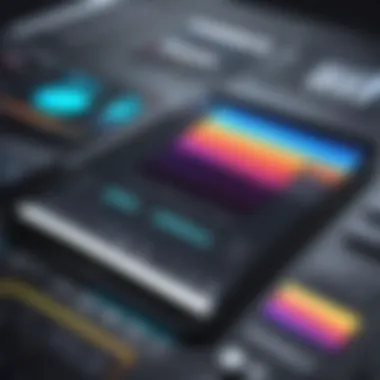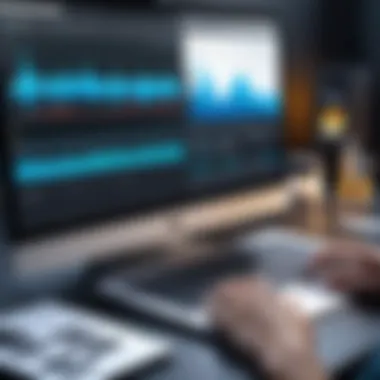Exploring Music-Enhanced Editing Apps for Creators


Intro
In today's digital age, creating compelling content requires more than just basic tools; it necessitates a blend of creativity and technical capabilities. Editing applications have become essential for content creators, influencers, and marketers alike. Among these tools, apps that integrate music features stand out, offering unique ways to enhance videos and audio presentations. This article delves into the landscape of such applications, focusing on how they incorporate music functionalities to improve user experience and foster creative expression.
Key Features
Editing apps with music features present a variety of functionalities that enhance the editing process. Here are some of the notable characteristics:
- Audio Library Access: Many applications, like Adobe Premiere Pro and iMovie, provide extensive libraries of royalty-free music tracks. Users can easily find the right sound to complement their visuals.
- Audio Editing Tools: Features such as trimming, fading, and volume controls allow for seamless integration of music with other audio components. Tools like Final Cut Pro X offer advanced audio manipulation to ensure professional-quality output.
- Real-time Collaboration: Apps such as WeVideo and Kapwing facilitate collaborations. This allows multiple users to work on a project simultaneously, sharing music and audio edits instantly.
- User-friendly Interface: A well-designed interface can simplify the editing process. Easy access to music cues and drag-and-drop functionalities are vital for efficiency.
- Mobile Compatibility: With the rise of mobile content creation, many music editing apps, like Splice and Alight Motion, operate effectively on smartphones and tablets, making it easier to create content on the go.
Product Specifications
To fully understand the capabilities of these editing apps, one should consider multiple specifications.
Technical Specifications
- Supported Formats: Commonly supported formats include MP3, WAV, and AAC for audio. For video, formats like MP4 and MOV are essential for compatibility with most devices.
- Processing Power: Advanced apps usually require robust processing power to handle high-resolution videos and complex audio editing. Check whether the app is optimized for performance on various devices.
Compatibility and Connectivity
- Device Compatibility: Consider whether the app is available on multiple platforms, including Windows, macOS, iOS, and Android. Software like Filmora is widely compatible across different systems.
- Cloud Storage Integration: Many modern editing apps integrate with cloud services like Google Drive and Dropbox. This allows users to save and access projects from any device.
"The capability of integrating music within editing apps is a game-changer, elevating the creative potential and enabling richer storytelling through sound."
This detailed exploration will help content creators make informed choices when selecting editing apps. With technology constantly evolving, being aware of the trends and features will enhance the overall digital content creation experience.
Intro to Editing Apps with Music
The integration of music features within editing apps has transformed the way content creators approach digital projects. Music adds depth, emotion, and engagement to video and audio content. Thus, understanding these tools is essential for anyone involved in digital creation.
Editing apps with music capabilities provide numerous benefits. First, they enhance the creative process. Users can experiment with different soundtracks to see how they alter the mood and narrative of a project. Second, these apps often offer built-in libraries, which save time. Users can access pre-licensed music without the hassle of searching for tracks elsewhere.
Moreover, the consideration of music accessibility is crucial. Many creators face challenges related to copyright when adding music to their projects. Editing apps that simplify licensing can remove this barrier, enabling more creators to use music legally and ethically.
The audience for these tools spans diverse genres, from filmmakers to social media influencers and podcasters. Each group can leverage music features to impact their content positively. The seamless incorporation of audio can lead to better audience retention and improved storytelling.
"Music is not just an addition to visual content; it is an essential component that shapes the viewer's experience."
The Importance of Music in Digital Editing
Music serves not just as background noise in digital content; it is a fundamental element that shapes the viewing experience. The presence of music can create an emotional backdrop, frame narratives, and enhance storytelling. It is pivotal in how audiences perceive and engage with videos, making its integration into editing apps essential. In an age of increasing competition in digital content creation, the ability to leverage music effectively becomes a significant advantage for creators.
Emotional Impact of Music
In digital editing, music evokes emotions that can transform a mere video into an impactful storytelling medium. Different genres of music induce various moods; for instance, classical pieces may evoke nostalgia, while upbeat tracks generate excitement. The strategic selection of soundtracks allows editors to simultaneously convey messages and establish an emotional connection with the audience.


An effective use of sound can increase a sense of authenticity and depth in projects, turning them into relatable experiences for viewers. When music is thoughtfully paired with visuals, it enhances the emotional resonance of a scene, influencing how it is perceived. This understanding encourages content creators to curate their music choices meticulously, improving overall narrative cohesiveness.
"Soundtrack can amplify a narrative, bringing stories to life in ways that visuals alone cannot."
Enhancing Viewer Engagement
Music is a driving force in maintaining viewer interest. Research indicates that audiovisual content is more engaging than visual content alone. When accompanied by the right soundtrack, videos captivate attention, reducing viewer drop-off rates. Editing apps that integrate music features can facilitate dynamic content creation, allowing seamless transitions and enhancing momentum in storytelling.
Consider the use of music in promotional videos. Adding an energetic track can boost excitement and urgency, persuading viewers to take action. Similarly, a soft instrumental piece may work wonders in narrative films or personal vlogs, fostering a more intimate connection. The interactive elements provided by today’s editing applications mean that content creators can experiment with soundscapes to push creative boundaries and offer fresh experiences.
A few key benefits of music in digital editing are:
- Setting a tone: Establishes the mood of the content quickly.
- Boosts retention: Helps audiences remember key messages.
- Encourages sharing: Engaging music can make content more sharable across platforms.
As a result, understanding the importance of music in digital editing may provide creators with an edge in a vibrant content landscape. Editors must consider music's dual role—both as an emotional trigger and as a tool for enhancing viewer interaction.
Key Features of Editing Apps Incorporating Music
In the realm of digital content creation, editing apps equipped with music functionalities stand out for their ability to elevate the quality and emotional resonance of projects. These apps serve as powerful tools that not only streamline the editing process but also enhance creative expression. When considering the key features of editing apps incorporating music, several elements come into play:
- Audio Editing Functions:
- Music Libraries and Licensing:
- Integration with Streaming Services:
- The ability to manipulate sound is fundamental. Apps like Adobe Premiere Pro allow users to cut, fade, and adjust the volume of audio tracks seamlessly. This ensures that the audio matches the video perfectly, providing a cohesive experience.
- Some apps offer advanced features such as multi-track editing, enabling users to layer various sounds. This is crucial for creating immersive soundscapes that captivate audiences.
- A vast library of music can greatly enhance an editing app's utility. Users can easily find tracks that fit the tone of their projects without needing to source music elsewhere. Software like Filmora provides access to a range of genres, catering to various tastes and themes.
- Licensing is another critical aspect. Many apps ensure that the music offered is free from copyright issues, which saves users from potential legal troubles. Understanding licensing options is essential for creators who intend to share their work commercially.
- The integration of popular streaming services into editing apps marks a significant advancement. For instance, LumaFusion allows direct access to platforms like SoundCloud or Spotify. This lets users incorporate trendy tracks that could resonate better with their audience.
- The ability to use music from these platforms also means that editors can stay up-to-date with the latest hits and trends, making their projects more relevant.
In summary, the key features of editing apps that include music functionalities are not just about the sound; they encompass a range of tools and resources that empower users to create polished and engaging content. Understanding these features is crucial for anyone looking to maximize their editing capabilities in an increasingly music-driven digital landscape.
Notable Editing Apps with Music Capabilities
The integration of music into editing applications enhances not only the aesthetic appeal of video projects but also influences viewer engagement and emotional resonance. In today's content-driven world, notable editing apps provide crucial functionalities that enable creators to tap into a diverse range of music features. These features are vital for professionals and hobbyists alike, facilitating smooth workflows and creative expression.
When selecting an editing app with music capabilities, it is essential to consider the array of tools available for audio editing, the quality of music libraries, and licensing options. Furthermore, the effectiveness of these applications often lies in their user-friendly interface and the ability to integrate with popular streaming services. Below is a deeper exploration of some prominent editing apps renowned for their music integration.
Adobe Premiere Pro
Adobe Premiere Pro stands out as a leading choice among professional video editors. Its powerful music capabilities come from a combination of advanced audio editing tools and access to a vast music library through Adobe Stock.
Users can edit audio tracks with precision and apply effects seamlessly. Additionally, Premiere Pro supports direct integrations with services like Soundstripe, enabling quick licensing for high-quality music selections, enhancing the overall production quality.
Adobe’s community offers extensive tutorials, which aids newcomers in leveraging music features effectively. These elements make Premiere Pro a top choice for both novice and experienced editors.
Final Cut Pro


Final Cut Pro X is another formidable editing software for Mac users. It offers impressive sound editing features that align well with its sophisticated video editing capabilities. The app includes a built-in audio editing suite that allows users to mix, match, and layer music tracks efficiently.
Final Cut Pro X also benefits from a rich ecosystem of plugins and music libraries, such as the popular Artlist that can be integrated for selecting appropriate soundtracks. These elements contribute to a dynamic editing experience, allowing creators to build engaging narratives through audio and visual collaboration.
iMovie
For casual users and those who seek simplicity, iMovie provides a straightforward interface that is easy to navigate. Despite its basic design, it facilitates the incorporation of music tracks effectively.
iMovie includes a variety of sound effects and royalty-free music options that users can drag and drop into their projects. It is a suitable choice for beginners who need fundamental tools to edit videos in a user-friendly environment while still being able to use music creatively.
Filmora
Filmora is another excellent option that appeals to both new and seasoned users. The software provides an extensive library of soundtracks and sound effects, which users can access easily. Its intuitive interface allows for quick integration of music tracks, making the editing process efficient.
Moreover, Filmora offers advanced audio tools such as background noise removal and audio equalization, enhancing the quality of the final product. This capability makes it suitable for creators who want to elevate their video projects with a polished sound.
LumaFusion
LumaFusion is particularly popular among mobile editors. This app provides a robust set of music features that cater to users who work on the go. It allows for multi-track editing, making it easy to layer tracks and adjust audio levels directly on a mobile device.
With access to extensive music libraries, creators can confidently select soundtracks that resonate with their projects. LumaFusion’s capabilities position it as a strong choice for aspiring filmmakers and social media influencers looking for effective mobile editing solutions.
In summary, the landscape of editing apps equipped with music features is diverse. Each of these platforms brings unique strengths to the table, serving different needs and skill levels. Emphasizing the integration of music within editing workflows continues to be a significant trend, highlighting the ongoing connection between sound and visual storytelling.
Output Formats Supported by Editing Apps
Understanding the output formats supported by editing apps is crucial for users who want flexibility and compatibility in their projects. In the context of digital content creation, various output formats can influence how a finished piece is distributed and consumed. If the desired format is not supported, it can lead to limitations in the sharing, playback, or even the overall quality of the content.
Audio File Formats
Audio file formats play a significant role in the editing process. When working with music in editing applications, having a variety of supported audio formats ensures that users can utilize different audio sources without issue. Common formats like MP3, WAV, and AAC are essential because they are widely recognized and compatible with most devices and platforms.
- MP3 is popular for its small file size and reasonable quality, making it ideal for streaming and sharing online.
- WAV, on the other hand, offers uncompressed audio, providing the best sound quality but at the cost of larger files.
- AAC is advantageous for quality compression and is preferred by many music streaming services.
Choosing the right audio format affects both the editing experience and the output quality of the final product. Users must consider factors such as fidelity, editing capabilities, and integration with other tools or platforms.
Video File Formats
Video file formats are another critical aspect to consider when using editing apps that incorporate music features. Different formats serve distinct purposes and have varying levels of compatibility with devices and software.
Common video formats include:
- MP4: This is perhaps the most universally accepted format. It balances high quality with reasonable file size, making it ideal for online sharing.
- AVI: Known for its excellent video quality, AVI files can be quite large and may not be as easily shareable as more compressed formats.
- MOV: This format provides high-quality video and is commonly used for editing, especially in Apple’s ecosystem. It works well with Final Cut Pro and iMovie.
Identifying the proper video format ensures that the edited content maintains quality and is usable on various platforms without running into playback issues. Users should be aware of the required formats for different distribution channels, such as YouTube or social media platforms, to optimize their content effectively.


"Choosing the right format can save time and enhance the viewer's experience by ensuring smooth playback across different devices."
By paying attention to supported output formats, users can create content that not only feels professional but also meets the demands of today's digital landscape. The flexibility in choosing formats not only aids in the editing process but also enhances the reach and impact of the creative work.
User Experience and Interface Design
Creating a positive user experience is critical in the realm of editing apps that incorporate music features. The design and functionality of these applications should be intuitive, allowing users to easily navigate through various functionalities without feeling overwhelmed. This aspect is especially relevant in editing apps because users come from diverse backgrounds. Some may be seasoned professionals while others might be newcomers trying to explore creative outlets.
Intuitive Navigation
Intuitive navigation serves as a backbone for effective user experience in music editing applications. Users should find it easy to locate necessary tools, including audio editing functions and ready-to-use music libraries. A well-organized layout reduces the time spent on learning the app and instead allows users to focus on their creative process.
For instance, applications like Adobe Premiere Pro offer a customizable workspace, where users can arrange tools and features according to their preferences. This adaptability caters to individual workflows, making the application more user-friendly. Easy access to shortcuts can further streamline navigation, enhancing overall productivity.
Customization Options
Customization plays a pivotal role in enhancing user experience within editing apps. Users appreciate the ability to personalize their interfaces, as it can significantly affect their workflow. Features such as adjustable toolbars and modifiable themes allow users to create an environment that resonates with their individual style.
Moreover, customization can extend to functionality as well. For example, some apps enable the creation of custom presets for frequently used audio settings or effects. This capability not only saves time but also improves consistency across projects. It empowers users to express their unique creativity while simplifying repetitive tasks.
The emphasis on user experience and interface design ultimately translates into improved efficiency and satisfaction. As creativity thrives in an environment that feels comfortable and tailored, the relationship between music features and editing becomes more seamless. The future evolution of these applications will likely continue to focus on enhancing user experience, making music integration a more natural part of the editing process.
The Future of Music Integration in Editing Apps
The future of music integration in editing apps is pivotal for the ongoing evolution of digital content creation. As technology advances, applications are increasingly becoming more sophisticated, providing dynamic features that enhance both the editing process and the final output. This convergence of editing and music features redefines how creators interact with media, streamlining workflows and expanding creative possibilities. The integration of music functionalities is no longer a mere add-on; it is becoming a core aspect of how users conceive, design, and distribute their projects.
AI-Powered Music Editing
Artificial intelligence is revolutionizing music editing within applications. The utilization of AI allows for more precise audio adjustments, making the editing process less time-consuming. Users can expect features such as automatic music suggestions based on the content being edited. For instance, an AI could analyze the mood of a video and propose background tracks that resonate with the visual elements. This approach not only simplifies the user experience but also enhances the emotional consistency of the project.
AI can also help in creating unique soundscapes tailored to specific needs. By learning from user preferences and previous projects, these applications become more intuitive, thus providing a personalized experience. Importantly, as AI continues to develop, the accuracy of such tools will improve, further bridging the gap between creativity and technical proficiency.
Emerging Trends in Music Licensing
As the landscape of digital content creation evolves, so does the framework of music licensing. Emerging trends indicate a shift towards more flexible and user-friendly licensing models. The classic traditional licensing routes can be cumbersome for users, often leading to delays and additional costs. However, many editing apps are now incorporating innovative licensing solutions that allow seamless integration of music without extensive legal hurdles.
Subscription models for music libraries are gaining traction. These models provide users with access to vast collections of music for a fixed monthly fee, promoting greater creativity without the worry of copyright infringement. As users become more aware of their legal rights when using music, the demand for transparency in licensing will likely increase. This transition presents a significant advantage for both creators and developers, facilitating an environment where new projects can flourish.
In summary, as editing apps develop, the incorporation of music functionalities becomes central. With AI enhancements and evolving licensing trends, the future looks promising for those looking to fuse sound with visual creativity.
The importance of these developments cannot be understated. They pave the way for a generation of content creators who can harness powerful tools to express their visions with greater accuracy and ease.
Finale
In the context of this article, the conclusion serves as a synthesis of the crucial points discussed regarding editing apps that incorporate music features. These applications have transformed the landscape of digital content creation, allowing users to blend audio and video in ways that enhance storytelling. The integration of music functionality is not just a luxury but an essential component for producing engaging content.
One significant element highlighted throughout is the emotional resonance that music can instill in videos. The right audio selections can deepen viewer connections, making the experience more memorable. This applies to a wide range of users—from vloggers to filmmakers—who need to evoke specific feelings in their audience.
Furthermore, the article examined the features that characterize leading editing applications. Music libraries, audio editing tools, and support for streaming services have become industry standards that enhance creativity and streamline workflows. Users can now find their ideal soundtracks without leaving the editing environment, fostering a more unified creative process.
Moreover, as technology continues to evolve, so does the future of music integration in editing apps. Innovations such as AI-powered music editing tools are anticipated to reshape how users interact with audio, offering enhanced customization and automation. Keeping abreast of these trends is vital for tech-savvy individuals who desire to remain at the forefront of content creation.
In summary, the importance of music features in editing applications cannot be overstated. The integration of these tools not only enriches the editing experience but also opens up new realms of creative possibilities. For those interested in exploring and adopting such technologies, the tools mentioned serve as compelling options that cater to diverse needs in digital editing.



